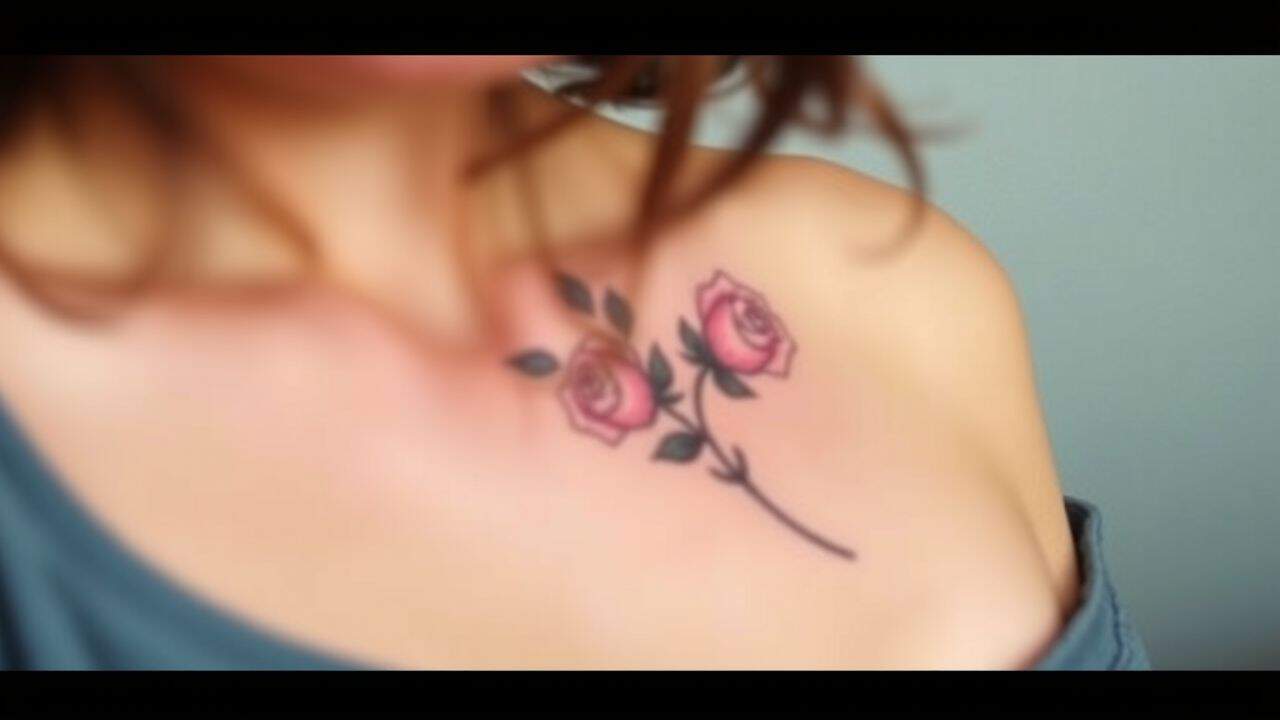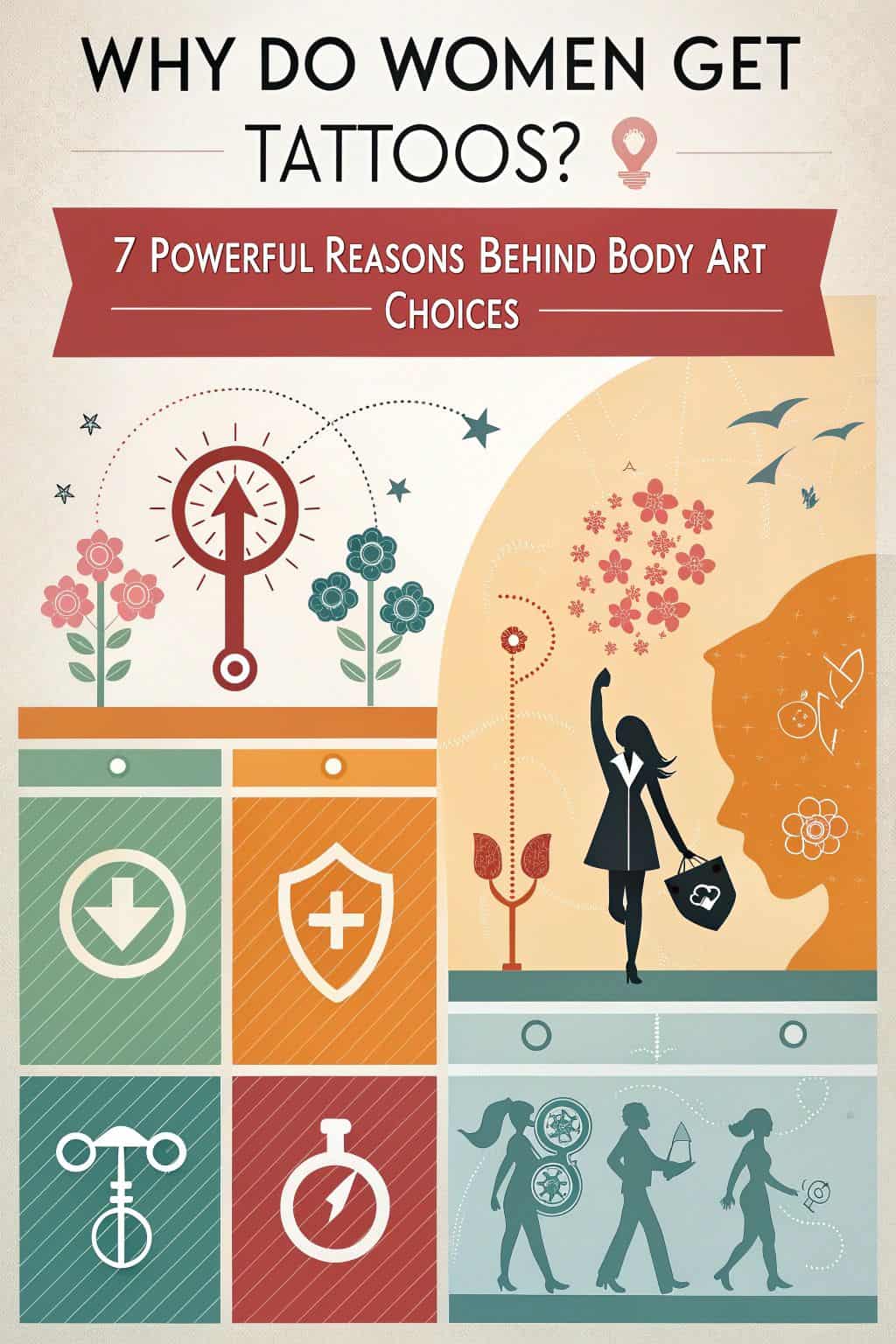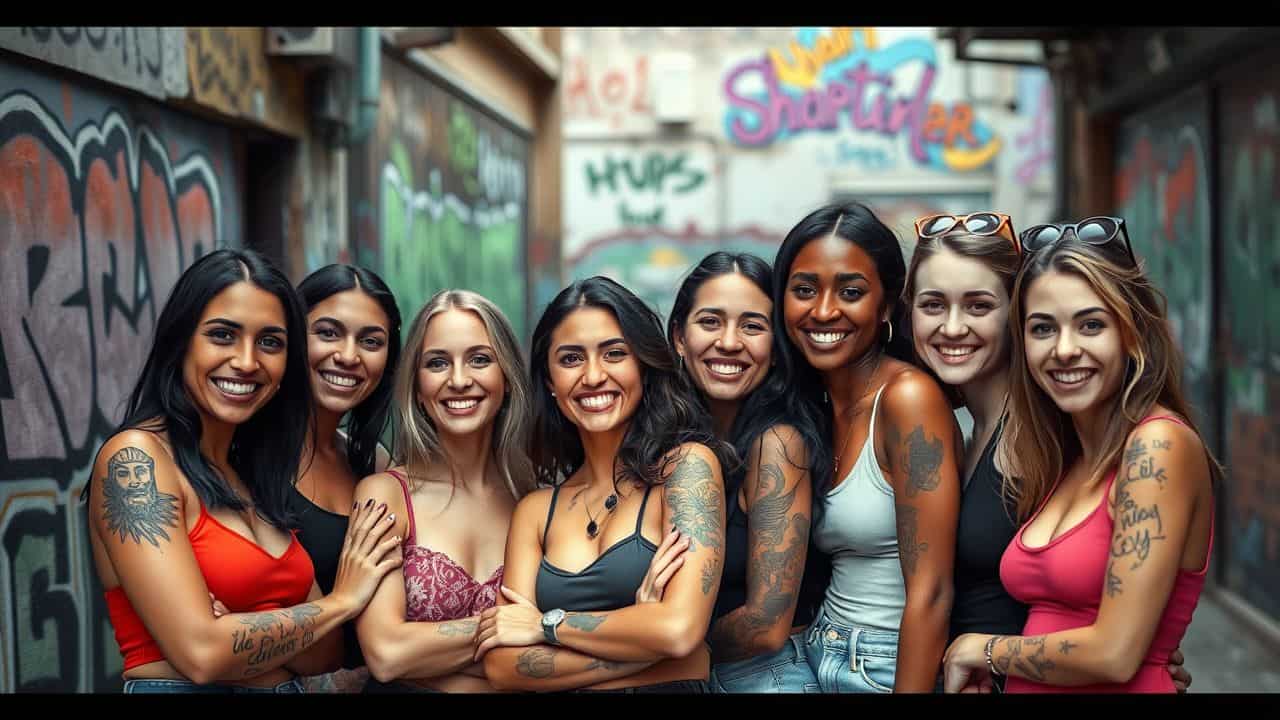Many women wonder “why do women get tattoos” as they think about getting their first ink. Studies show that 23% of American women have at least one tattoo, marking a huge rise from past decades.
This article explores seven key reasons behind women’s choices to get body art, from personal expression to emotional healing. Ready to discover what drives women to embrace permanent ink?
Key Takeaways
23% of American women have tattoos, showing a major rise in recent decades. Women aged 18-34 lead this trend, with 40% having at least one tattoo.
Women get tattoos mainly for personal expression, emotional healing, and marking life milestones. Many use body art to process trauma, boost confidence, and challenge beauty standards.
British females lead males by 8% in tattoo ownership as of 2015. This shows growing acceptance of body art among women across Western cultures.
Celebrities like Rihanna and Angelina Jolie have helped normalize tattoos for women. Their influence has made body art more accepted in workplaces and social settings.
Many women face unfair judgment about their tattoos. Yet studies show less stigma now than ten years ago. More women keep getting inked despite these challenges.
Table of Contents
Exploring Personal Expression through Tattoos

Women pick tattoos to tell their stories in bold, permanent ways. Each design serves as a window into their souls, showing off their inner thoughts and life-changing moments.
Showcasing Individuality

Tattoos let people paint their life stories on their skin. Each design speaks volumes about personal values and inner strength. I got my first tattoo to mark my journey through depression, and it became my badge of courage.
Many folks pick hot female tattoo ideas that match their self-image and beliefs. Body art breaks free from cookie-cutter beauty rules.
My body is my journal, and my tattoos are my story. – Unknown
The rise in tattoo culture shows how people embrace their true selves more openly now. Studies show that 40% of adults aged 18-34 rock at least one tattoo as a form of self-expression.
The ink on our skin tells tales of triumph, love, and growth. Some pick small, hidden designs while others go bold with full sleeves. Each choice reflects a personal journey toward self-discovery and body ownership.
Commemorating Significant Life Events

Life-changing moments deserve special recognition. Many women choose permanent body art to mark their personal victories and transformations. The art serves as a constant reminder of their growth, strength, and self-awareness.
Some ladies get inked to honor their married couple tattoos or celebrate the birth of their children. Others mark career achievements, recovery milestones, or personal breakthroughs.

Body art tells personal stories through symbols and designs. Each piece captures emotions and memories tied to major life changes. The process helps women express their identity and psychological growth.
Many find healing through this form of self-expression, especially after facing tough times. The permanent nature of ink makes it perfect for preserving these meaningful experiences.
Moving forward, let’s explore how emotional healing plays a role in women’s tattoo choices.
Advocating Beliefs and Values
Tattoos serve as powerful statements of personal beliefs and core values. Many women choose body art to showcase their stance on social issues, spiritual beliefs, or life philosophies.
The permanent nature of tattoos makes them perfect tools for expressing deep-rooted convictions. I got my first tattoo of a peace symbol to show my commitment to non-violence and social justice.
Body art helps women take control of their self-perception and challenge social norms. Research shows tattoos boost confidence in women who face pressure to fit traditional beauty standards.
The art becomes a form of body-image advocacy, letting women reclaim their bodies through meaningful symbols. Each tattoo tells a story of personal values and growth, turning skin into a canvas for self-expression and empowerment.
Emotional and Psychological Reasons for Tattoos

Getting a tattoo often helps women heal from deep emotional wounds and build stronger self-worth. The act of marking one’s skin creates a powerful shift in personal identity, giving women control over their body image and life narrative.
Healing from Past Trauma
Many women turn to tattoos as a powerful way to heal from trauma. Body art helps process difficult emotions and reclaim control after tough experiences. I’ve seen countless women transform their scars into beautiful symbols of survival.
The act of getting inked creates a safe space for emotional release and personal growth.
Tattoos serve as visual reminders of inner strength and resilience. The physical pain of tattooing can help release emotional pain, creating a therapeutic experience. Some women choose to wash a new tattoo while reflecting on their healing journey.
The process builds self-esteem and aids in recovery from historical trauma.
My tattoos tell the story of how I survived, and remind me daily of my strength. – Sarah M., Trauma Survivor
Moving forward, many women find that tattoos boost their confidence in remarkable ways…
Boosting Self-Esteem
The path from healing to confidence leads straight through self-expression. Body art serves as a powerful boost to self-esteem for countless women. Tattoos create a strong sense of body ownership, helping women feel more in control of their appearance.
Research shows tattooed women view their bodies more favorably than those without ink. The act of choosing and wearing permanent art makes women feel bold and empowered.
Getting inked helps reshape body image in positive ways. Women report feeling more confident after getting tattoos that showcase their personal style. The art becomes part of their identity and self-acceptance journey.
Some women use tattoos to cover scars or perceived flaws, turning them into beautiful designs. This transformation often leads to improved self-worth and body satisfaction. The growing social acceptance of tattoos has made more women feel comfortable expressing themselves through body art.
Their enhanced self-esteem shows in how they carry themselves with pride.
Shaping a Personal Identity
Growing self-esteem through tattoos leads many women to discover their true identity. Body art serves as a powerful tool for personal growth and self-discovery. Each tattoo tells a story about who we are and what matters most to us.
Women often choose designs that reflect their values, beliefs, and life experiences.
Tattoos help women break free from society’s beauty rules and create their own path. Many women report feeling more connected to themselves after getting inked. I’ve seen countless friends transform their self-image through meaningful tattoos.
These permanent marks become part of our personal construct psychology, helping us make sense of who we are. Tattoos give women a chance to express their inner world on their skin, turning private feelings into visible art.
This kind of self-expression builds confidence and shapes how we view ourselves in the mirror each day.
The Artistic and Aesthetic Appeal of Tattoos

Women pick tattoos as living art pieces that tell stories through colors, shapes, and personal meaning – want to learn the secrets behind their bold choices? Keep reading to discover why more women embrace this form of self-expression.
Appreciating Body Art
Body art tells stories through skin. Each tattoo carries deep meaning and personal value beyond its visual appeal. The rise in tattoo popularity shows in recent stats – British females lead with 8% more ink than males as of 2015.
I’ve noticed how tattoos spark conversations about art appreciation, personal growth, and cultural shifts in beauty standards.
My body is my journal, and my tattoos are my story. – Unknown
The artistic merit of tattoos goes deeper than surface-level beauty. Master tattoo artists blend color theory, composition, and technical skill to create lasting masterpieces. The process builds trust between artist and canvas, turning skin into a living gallery.
Next, let’s explore how talented artists bring these visions to life through their craft and expertise.
Working with Tattoo Artists
Finding the right tattoo artist feels like matchmaking for your skin. Professional artists bring your ideas to life through their creative skills and deep knowledge of skin art. Many women prefer artists who make them feel comfortable and heard during consultations.
The best artists take time to understand your vision, explain their process, and share their portfolios. They focus on safety, using sterile equipment and following strict health guidelines.
A good artist will guide you through design choices that suit your style and skin tone. They’ll explain how certain colors work on different skin types and suggest placement options that age well.
Most artists welcome questions about their experience and techniques. Your comfort matters as much as their artistic ability. The connection between client and artist shapes the final result of your body art.
Let’s explore how tattoos serve as powerful symbols of personal identity and growth.
Crafting Unique Visual Statements
Body art lets women tell their stories through skin. Each tattoo becomes a bold statement of personal growth and life choices. I’ve seen countless women transform their bodies into living canvases, picking designs that speak to their souls.
The art ranges from tiny symbols to full sleeves, each marking a chapter in their journey.
Tattoos break free from cookie-cutter beauty rules. Many women pick custom designs that show who they really are, not what society expects. The process needs careful thought and talks with artists who get their vision.
My sister chose a delicate flower pattern that wraps around her wrist. It shows her love for nature and marks her recovery from a tough time. Her tattoo proves that body art can both look beautiful and carry deep meaning.
Cultural and Societal Factors Influencing Tattoo Decisions

Today’s society shows more openness to tattoos than ever before, marking a big shift from past views about body art. Social media and pop culture have shaped how we see tattoos, creating new attitudes about self-expression through body modification.
Shifting Gender Norms
Gender norms have changed a lot in recent years. More women now see tattoos as a way to own their bodies and express themselves freely. This shift shows how women break free from old rules about how they should look or act.
Many women pick tattoos to show their strength and challenge outdated ideas about beauty.
Society’s view of tattooed women keeps changing for the better. Studies show that women with tattoos face less judgment than they did ten years ago. Still, some people hold negative views about women who get inked.
These old attitudes don’t stop modern women from making bold choices about their bodies. Women now use tattoos to create their own identity and challenge what others think is ‘feminine.’ This self-expression through body art proves that women won’t let others define their choices anymore.
Recognizing Tattoo Acceptance in Society
Society’s view of tattoos has changed a lot in recent years. More women now sport body art without facing harsh judgment. Media and celebrities play a big role in this shift. I’ve noticed how TV shows, magazines, and social media celebrate tattooed women instead of shaming them.
Famous actresses and musicians proudly display their small catholic tattoos and other meaningful designs, making body art more normal in daily life.
Professional spaces show growing acceptance, too. Many offices now let employees show their tattoos at work. This shift helps women feel more confident about their body art choices.
The rise in acceptance connects to deeper changes in how we view self-expression and body ownership. Research shows that Western culture increasingly sees tattoos as art rather than rebellion.
This acceptance helps reduce the old stigma that made many women hide their tattoos. Still, some spaces hold on to old biases, but the trend moves clearly toward acceptance and understanding.
Influences from Media and Celebrities
Social media stars and celebrities have changed how women view tattoos. Popular figures like Rihanna and Angelina Jolie proudly show their body art on red carpets and magazine covers.
Their bold choices inspire many women to explore self-expression through tattoos. Famous tattoo artists now gain huge followings on Instagram, sharing their work with millions of followers daily.
Media platforms showcase diverse tattoo styles and meanings, breaking old taboos about women with ink. TV shows about tattoo culture have made body art more mainstream. Female celebrities often share personal stories behind their tattoos, connecting them to self-actualization and emotional healing.
This open discussion helps reduce stigma and encourages women to view tattoos as a form of artistic expression rather than rebellion.
Tattoos as a Form of Feminism and Empowerment

Women use tattoos to claim control over their bodies and challenge old beauty rules. Their ink tells stories of breaking free from social limits, much like how Emma Goldman fought for women’s rights through bold actions.
Asserting Body Ownership
Tattoos give you power over your body. Each ink mark tells your story, your way. Many people still think they can control how others look, but tattoos break those chains. Body art lets you reclaim what’s yours.
Your skin becomes a canvas for self-expression, free from society’s rules.
Getting inked helps tackle low self-esteem and builds confidence. The choice to get a tattoo sends a clear message: “My body belongs to me.” This act of taking control fights against outdated beauty standards.
I got my first tattoo at 25 to mark my freedom from an abusive relationship. That small butterfly on my wrist reminds me daily of my strength and independence. Through introspection and personal growth, tattoos become powerful symbols of self-ownership.
Resisting Traditional Beauty Standards
Many women break free from beauty norms through body art. Society pushes a narrow view of female beauty – perfect skin, zero marks, and flawless surfaces. Yet more ladies now reject these limits through meaningful ink.
Body art serves as a bold statement against cookie-cutter standards. I’ve seen countless women transform their perceived “flaws” into beautiful designs, making their bodies a canvas of self-expression.
Modern women embrace their right to modify their bodies as they see fit. This shift reflects deeper changes in how society views female autonomy and rights. The rise in female tattoo artists has helped create safe spaces for women to explore their artistic vision.
Female clients often pick designs that challenge old beauty rules. Some choose large, visible pieces instead of small, hidden ones. This growing trend shows how women use their bodies to fight back against outdated beauty ideals.
Next, we’ll explore how tattoos become powerful tools for activism.
Embracing Tattoos as Activism
Women turn their bodies into powerful billboards for social change through tattoos. Their skin becomes a canvas for messages about feminism, equality, and personal freedom. Tattoos break traditional beauty rules and challenge old-fashioned ideas about how women should look.
This form of activism speaks volumes without saying a word, pushing back against unfair beauty standards that have controlled women for generations.
Body art serves as a bold statement of self-ownership and resistance. More women now choose tattoos to express their stance on social issues, from women’s rights to body positivity.
The rise in female tattoo artists and clients shows a clear shift in cultural attitudes. These permanent marks tell stories of strength, survival, and solidarity with other women. Through tattoos, women claim control over their bodies and challenge society’s expectations about feminine beauty.
Tattoos Symbolizing Resilience and Strength

Women choose tattoos as powerful symbols of their inner strength, marking life’s battles and victories on their skin – from surviving trauma to celebrating personal wins. Want to learn more about how tattoos become badges of courage? Keep reading!
Celebrating Personal Milestones
Tattoos mark life’s big moments in bold, permanent strokes. Many people get inked to celebrate beating cancer, graduating college, or becoming a parent. These personal victories shine through meaningful symbols on their skin.
The art speaks volumes about their growth, strength, and self-discovery journey.
Body art helps process major life changes and honors personal growth. A small butterfly might show freedom from past trauma. A date in Roman numerals could mark the day someone got sober.
Each tattoo tells a story of triumph, serving as a daily reminder of how far they’ve come. The marks on their skin reflect inner strength and personal transformation.
Facing Societal Judgment
Many women face harsh judgment about their tattoos in daily life. Society often views tattooed women through a negative lens, questioning their choices and character. I’ve noticed people make snap decisions about my skills and values just because of my visible arm tattoo.
Some folks still link body art to rebellion or poor decision-making, which creates unfair barriers in professional settings.
Negative reactions from others can shake a woman’s self-esteem and body image. People stare, make rude comments, or treat tattooed women differently at work or social events. Yet more women keep getting inked despite these challenges.
This shows real strength in the face of bigotry and outdated thinking. The rise in female tattoo artists and growing acceptance of body art proves that old stigmas are slowly fading.
Still, the path isn’t easy – dealing with judgment takes thick skin and a strong sense of self.
Embodying Strength and Independence
Breaking free from judgment leads women to embrace their inner power through tattoos. Body art serves as a bold statement of personal strength and autonomy. Women choose tattoos to mark their independence and showcase their resilience in life’s journey.
The act of getting inked helps boost self-esteem and creates a stronger sense of self.
Tattoos transform into powerful symbols of feminine strength and self-determination. Each design tells a story of personal growth, survival, or triumph. The permanent nature of tattoos mirrors a woman’s commitment to her own path.
Through body art, women express their authentic selves without fear or hesitation. The choice to get tattooed reflects a deep connection to personal values and individual expression.
Addressing Misconceptions About Tattooed Women

Women with tattoos break free from old myths about their character or life choices. Society now sees tattoos as personal art, not signs of rebellion or poor judgment.
Confronting Stereotypes and Biases
Tattooed ladies still face unfair judgment in many spaces. People often link tattoos to negative traits like rebellion or poor decision-making. I’ve noticed how society treats men with tattoos differently than women.
Men get praised for their ink while people question a woman’s choices. These biases stem from old-fashioned ideas about how ladies should look and act.
Breaking these stereotypes takes guts and persistence. Many tattooed women report facing workplace discrimination or family disapproval. Yet studies show more women now get tattoos as a form of self-expression and personal power.
The rise in female tattoo artists also helps fight these outdated views. My own tattoo sparked countless talks about art and identity, proving that body art creates bridges between people.
Each inked story chips away at harmful assumptions about tattooed women.
Understanding Evolving Perceptions
Society’s views on women with tattoos have shifted dramatically in recent years. More women now see tattoos as a powerful form of self-expression rather than rebellion. Studies show this change stems from broader acceptance of body art across different age groups.
Many professional spaces now welcome visible tattoos, marking a clear break from past stigmas. This shift reflects deeper changes in how we view personal identity and body ownership.
People’s attitudes about tattooed women vary based on factors like age and cultural background. Older generations often link tattoos to negative behavior, while younger people see them as normal self-expression.
Social media has played a big role in this change. Many women now share their tattoo stories online, helping break down old stereotypes. This open dialogue has created more understanding about why women choose to get inked.
Still, some workplace bias exists, especially in conservative industries.
Generational Perspectives on Tattoos

Today’s young women see tattoos as a normal part of life, unlike their grandmothers who often viewed body art as taboo. Shifting attitudes across age groups show how self-expression through tattoos has moved from the edges of society right into mainstream culture.
Embracing Tattoos Among Younger Women
Young women lead a tattoo revolution in modern society. Generation Z shows greater openness to body art than their parents or grandparents did. Social trends push many women to get inked, often due to peer influence.
Yet, this shift goes deeper than just following the crowd. Many young women use tattoos to express their true selves and take control of their bodies.
Tattoos serve as powerful tools for self-expression among younger females. Studies point to mixed effects on self-esteem, with some women feeling more confident and others facing judgment.
The rise in female tattoo artists has created safe spaces for women to share their stories through skin art. This growing acceptance shapes how society views women’s choices about their bodies.
The changing views on tattoos reflect broader shifts in how professional spaces treat body art.
Exploring Attitudinal Shifts Across Generations
Today’s views on tattoos show a clear split between age groups. Generation Z embraces body art as a normal part of self-expression. Their parents and grandparents often see tattoos as rebellious or unprofessional.
Social attitudes keep changing fast, especially for women with tattoos. Many older folks still hold negative opinions about tattooed women, while they judge men’s tattoos less harshly.
Society’s stance on body art has made big leaps in recent years. More workplaces now accept visible tattoos, though some resistance remains. Modern women face less judgment for their tattoo choices than previous generations did.
The shift reflects deeper changes in how we view personal expression and body autonomy. Research shows this acceptance grows stronger with each new generation, pointing to even more positive changes ahead.
Popular Tattoo Styles Among Women

Women love tattoos that tell stories through art. From tiny butterflies to bold geometric patterns, modern tattoo styles blend personal meaning with artistic flair.
Choosing Minimalistic and Delicate Designs
Delicate tattoo designs have gained massive popularity in recent years. Small, fine-lined artwork creates a subtle yet powerful statement on the skin. Most people pick these styles to boost their self-image and confidence.
The clean, simple patterns often include tiny symbols, thin script, or small geometric shapes that blend naturally with the body’s curves.
Minimalistic tattoos offer a perfect balance between self-expression and professional appearance. Studies show tattooed individuals feel more positive about their body image compared to those without ink.
The trend leans heavily toward simple designs that tell personal stories without overwhelming visual impact. My own tiny wrist tattoo, a small compass, draws compliments for its clean lines and meaningful symbolism.
These subtle marks let people express themselves while maintaining a polished look in any setting.
Seeking Symbolic and Meaningful Imagery
Beyond simple designs, women pick tattoos that tell their stories. Many women choose symbols that connect to their personal journeys, beliefs, and life-changing moments. These meaningful images serve as silent storytellers on their skin.
Tattoo artists report that female clients often bring deep personal meanings to their body art choices.
The power of symbolic tattoos lies in their ability to express complex feelings through simple images. A butterfly might represent freedom from past trauma. A lotus flower could show growth through tough times.
Women use these permanent marks as non-verbal ways to share their inner strength. The rise in meaningful tattoos among women shows a shift from pure decoration to powerful self-expression.
Body art now serves as a canvas for personal identity and emotional healing.
Opting for Full-Body or Large-Scale Tattoos
Full-body tattoos have gained massive popularity among women in recent years. More ladies now pick bold, large-scale designs that cover major parts of their bodies. These tattoos serve as powerful statements of self-ownership and personal expression.
Many women choose back pieces, sleeves, or leg designs that tell their life stories through art.
The rise of full-body tattoos links closely to changing views about beauty and feminism. Modern women see these extensive tattoos as a way to claim their bodies and challenge old beauty rules.
Media stars and social influencers have helped make big tattoos more accepted. Still, some women face judgment at work or in social settings for their body art choices. This reality shows how society still grapples with women’s right to express themselves through tattoos.
Challenges for Women in the Tattooing World

Women with tattoos still face judgment in many workplaces, leading to tough choices about showing or hiding their body art. Some female tattoo artists report feeling pushed out of male-dominated tattoo shops, which makes finding the right studio a critical step in their career path.
Managing Stigma in Professional Arenas
Professional spaces often judge tattooed people harshly. Many bosses still link body art to poor work habits or bad behavior. The stigma hits female workers harder, forcing them to cover up their tattoos with long sleeves or makeup.
This creates cognitive dissonance between personal expression and career growth.
Tacit workplace rules make life tough for tattooed staff members. Some companies flat-out ban visible tattoos, while others subtly discriminate during hiring. The pressure to look “professional” leads to self-esteem issues and stress.
Smart professionals fight back by proving their worth through excellent work, not appearance. They build strong interpersonal communication skills to challenge old-school thinking about body art.
Selecting Supportive Tattoo Artists
Finding the right tattoo artist matters as much as picking your design. A good artist listens to your ideas and respects your body image choices. They create a safe space where you feel comfortable sharing your vision.
Look for artists who show patience during consultations and answer all your questions clearly.
Your tattoo experience should feel positive from start to finish. Great artists maintain clean studios and follow strict health rules. They’ll share their portfolio and explain their style without pushing you to make quick decisions.
Many women prefer artists who understand feminine design elements and have experience with different skin types. Trust your gut feeling – if an artist makes you feel rushed or dismissed, keep searching until you find someone who treats you with respect.
People Also Ask
Why do women choose to get tattoos despite social stigma?
Women often get tattoos as a way to express their subjective experiences and tackle self-esteem issues. Some see it as a way to heal from historical traumas or childhood maltreatment. It’s not self-harm – it’s self-expression.
How do tattoos help women deal with past trauma?
Tattoos can help process abuse and neglect. Like a matrix of healing, body art helps women map their emotional journey on their skin. Research shows it can boost connectedness to nature and improve subjective wellbeing.
Do women regret getting tattoos more than men?
Studies on tattoo regret show mixed data. While some face ambivalence later, most women report positive affective responses. It’s not like breast implants – tattoos often carry deeper tacit knowledge and meaning.
How do mental health professionals view women’s tattoos?
Unlike old views linking tattoos to psychiatric disorders or evil spirits, modern researchers see body art differently. They use psychometric methods to study motives, finding many women use tattoos for positive exploration and evaluation.
Are women with tattoos more likely to have eating disorders?
This is a myth pushed by bigots. Quantitative studies show no direct correlation between tattoos and eating disorders. Body images and self-esteem issues need separate evaluation from tattoo choices.
What should women consider before getting a tattoo?
Women should process their conscious motives, consider sensory information about the process, and ignore outdated masculine views about tattoos. Smart planning beats later seeking tattoo removal. Remember: skin art isn’t just a trend – it’s personal expression.
